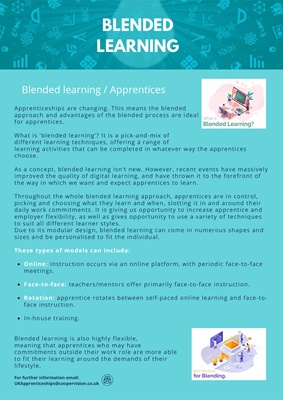
Online: instruction occurs via an online platform, with periodic face-to-face
meetings.
Face-to-face: teachers/mentors offer primarily face-to-face instruction.
Rotation: apprentice rotates between self-paced online learning and face-toface
instruction.
In-house training.
Apprenticeships are changing. This means the blended
approach and advantages of the blended process are ideal
for apprentices.
What is 'blended learning'? It is a pick-and-mix of
different learning techniques, offering a range of
learning activities that can be completed in whatever way the apprentices
choose.
As a concept, blended learning isn't new. However, recent events have massively
improved the quality of digital learning, and have thrown it to the forefront of
the way in which we want and expect apprentices to learn.
Throughout the whole blended learning approach, apprentices are in control,
picking and choosing what they learn and when, slotting it in and around their
daily work commitments. It is giving us opportunity to increase apprentice and
employer flexibility, as well as gives opportunity to use a variety of techniques
to suit all different learner styles.
Due to its modular design, blended learning can come in numerous shapes and
sizes and be personalised to fit the individual.
These types of models can include:
Blended learning is also highly flexible,
meaning that apprentices who may have
commitments outside their work role are more able
to fit their learning around the demands of their
lifestyle.
BLENDED
LEARNING
Blended learning / Apprentices
For further information email:
ukapprenticeships@coopervision.co.uk